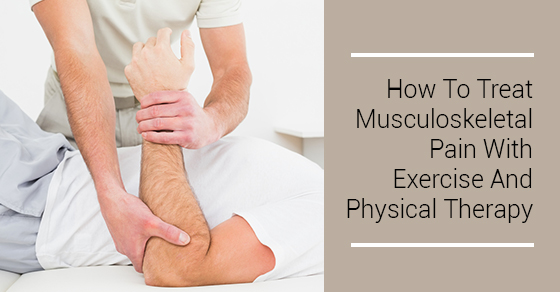Using Physical Therapy and Exercise for Musculoskeletal Pain Treatment
Musculoskeletal pain can be debilitating. Common symptoms of this particular type of pain can involve twitching or burning of the muscles. It can also cause you to lose sleep. In many cases, this pain is chronic and relying solely on prescription medications for treatment can have dangerous consequences.
After conducting a study on different approaches to treatment for musculoskeletal pain, the American Physical Therapy Association (APTA) spokesman Michael Walker, PT said: “It is important for consumers to know that there are effective, conservative solutions such as physical therapy available.” The study consisted of just under 100 participants randomly selected for two different approaches to treatment for neck pain. One approach consisted of physical therapist and exercise, while the other had to do with something called minimal intervention, whereby the patient received a combination of exercise regimen and prescribed medication.
As a result of this study along with several others, physical therapy was shown to be more productive and cost-effective in treating neck pain. The APTA – composed of about 70,000 plus physical therapists, assistants, and students. Some of the exercises in the study included, chin tucks and various range-of-motion exercises.
Physical therapists and other healthcare professionals are always in search of conditions that they can treat with the least invasive, most cost-effective, empirical methods. The intention on these techniques are to provide relief and comfort to patients while preventing prolonged recovery times due to surgery and opioid dependency. Strengthening muscles and stretching is a recommended approach to relieving neck and back pain associated with musculoskeletal disorders. Strengthening the muscles improves mobility and has been demonstrated to reduce pain.
Part of a therapist’s approach to improving patients’ mobility is by identifying weaknesses in movements that cause patients to overcompensate. Certain exercises will be recommended to balance the strain on joints and muscles, sometimes with the use of special machines or resistance bands. Lunges and squats are useful for strengthening the core and lower back by using the patient’s own body weight. Low-impact exercises are suggested especially to those with musculoskeletal disorders who may not be able to endure high-intensity workouts.
Yoga incorporate stretches and postures, coordinated with breathing. The focus of yoga is to relieve tension while also strengthening muscles. There are several different forms of yoga that target different muscle areas with various intensities. Patients can also practice yoga moves and other exercises at home when necessary.
Aromatherapy is often integrated into yoga sessions and has been recognized to be effective in psychosocial factors that can trigger chronic pain episodes. This form of therapy involves lighting essential oils (oil infused with herbal plant extracts). These oils are an extremely concentrated version of the plant itself, herbs which are considered to have a medicinal effect. For example, lavender and chamomile oils can be burned to help with sleep disruptions caused by musculoskeletal pain.
Therapeutic Massage has also been known to relieve musculoskeletal pain. This form of treatment also incorporates aromatherapy, by rubbing essential oils on the skin, as well as the burning technique mentioned above. Massage therapy works with the muscles through manipulation and pressure which can serve to ease tension and help with alignment.
Neuromuscular Therapy is especially beneficial for those experiencing musculoskeletal related pain. This therapy targets the root of chronic pain by addressing trigger points, postural, and biochemical issues. Other alternative forms of treatment exist that take a neurological approach regarding such functions as the mind-body connection and acupuncture – which stimulates the nervous system to release endorphins that block pain receptors.
Biofeedback is yet another alternative form of therapy that harnesses the mind-body connection. This method has been shown to be particularly beneficial in the treatment of chronic pain. The distinction between different types of biofeedback has to do with the measurement tools. Skeletal muscle contractions can be monitored using electromyography (EMG) sensors. The feedback data can then be assessed by a therapist to advise patients on adjustments in the movement that can be made to relax the muscles.
Although they may go by different names, all of the forms of therapy mentioned involving the use of the patient’s own physical body as an approach to treatment. Physical therapists are qualified to incorporate some of these methods into their regimen. This line of musculoskeletal pain treatment has shown to be a viable alternative to traditionally prescribed medication.
For more information on how you can treat the symptoms of musculoskeletal pain with physical therapy, contact Focus Physiotherapy. Focus Physiotherapy has 6 convenient physiotherapy clinic locations in the Greater Toronto Area: Etobicoke, Mississauga, Brampton, Bolton, North York and York. Please click one of the locations below for contact information, directions and hours of operation. We look forward to speaking with you.

